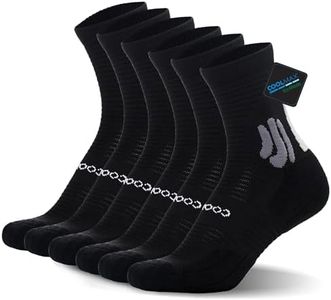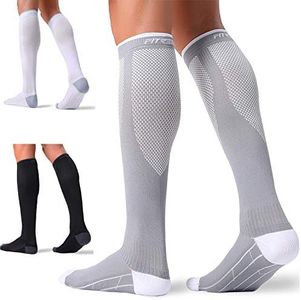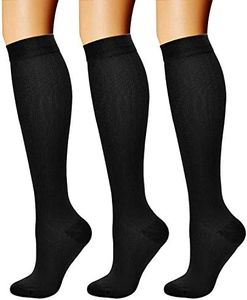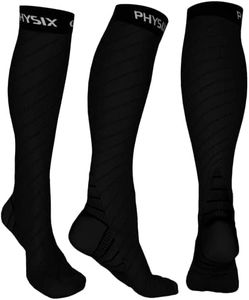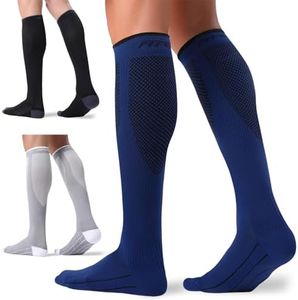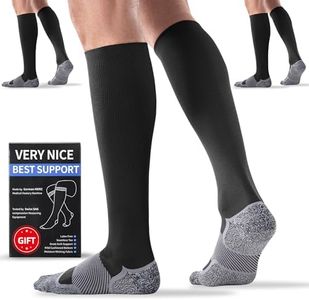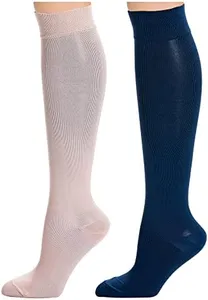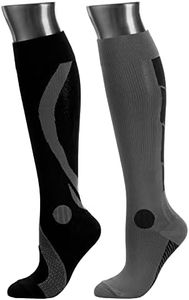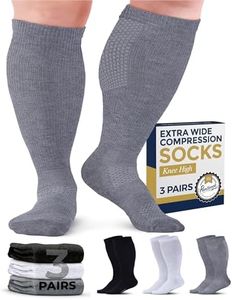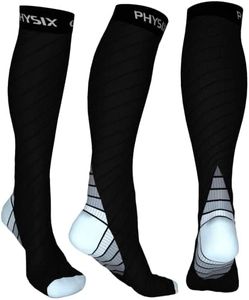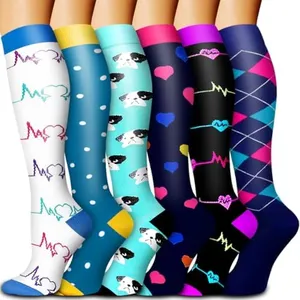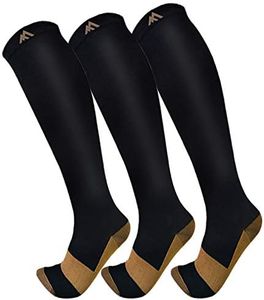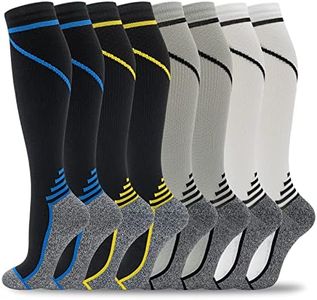10 Best Compression Socks 2025 in the United States
Our technology thoroughly searches through the online shopping world, reviewing hundreds of sites. We then process and analyze this information, updating in real-time to bring you the latest top-rated products. This way, you always get the best and most current options available.

Our Top Picks
Winner
FITRELL 3 Pairs Compression Socks for Women and Men 20-30mmHg- Circulation and Muscle Support Socks for Travel, Running, Nurse, Knee High, Medical Black+White+Grey L/XL
Most important from
30862 reviews
The FITRELL Compression Socks are designed for both men and women, offering a compression level of 20-30mmHg, which is suitable for enhancing circulation and providing muscle support. These socks are particularly beneficial for athletes, travelers, or anyone dealing with leg fatigue or swelling. One of the standout features is the moisture-wicking fabric that helps keep your feet dry and comfortable throughout the day, along with a breathable mesh design around the calf area.
Size options are tailored to fit various calf sizes, with S/M fitting calf sizes 9-15 inches, and L/XL for 14-16 inches. This thoughtful sizing can help ensure a snug fit for optimal compression. Additionally, the socks are equipped with cushioned soles that provide shock protection and comfort, making them ideal for running or long periods of standing.
There are a few considerations to keep in mind. The effectiveness of the compression may vary for different users, depending on individual needs and preferences. Some users might find the fit too tight, especially if choosing the size based on shoe size rather than calf measurement. The design, while functional, might not appeal to everyone as it sticks primarily to basic colors like black, white, and grey.
In terms of care, these socks are machine washable, which adds convenience for regular users. The FITRELL Compression Socks are a solid option for those seeking quality compression support for various activities, though it's essential to choose the right size to maximize their benefits.
Most important from
30862 reviews
CHARMKING Compression Socks (3 Pairs) - 15-20 mmHg, Athletic Support for Running, Cycling, Travel - Boost Circulation and Performance
Most important from
80189 reviews
CHARMKING Compression Socks offer a 15-20 mmHg compression level, which is ideal for improving circulation and aiding muscle recovery during activities like running, cycling, or even long periods of standing. The socks are made primarily of nylon (up to 85%), providing good stretch, durability, and breathability to keep your feet comfortable and at a steady temperature. They come in two size options (small-medium) and are designed to fit both men and women, although sizing choice is somewhat limited, so it's important to check if they match your foot size for the best fit.
These socks are knee-high length, which is effective for supporting the lower leg and calf muscles. The style is modern and simple, suitable for athletic use or everyday wear without looking out of place. Many users appreciate their lightweight feel and stable fit during movement. However, if you need a wider range of sizes or prefer different compression strengths, these might not cover all your needs. Also, the design is fairly basic, so if you're looking for more colors or patterns, options are limited.
They serve well for athletes and anyone needing moderate compression support throughout the day, making them a practical choice for improving circulation and reducing fatigue.
Most important from
80189 reviews
CHARMKING Compression Socks for Women & Men Circulation (3 Pairs) 15-20 mmHg is Best Athletic for Running, Flight Travel, Support, Cycling, Pregnant - Boost Performance, Durability (L/XL,Black)
Most important from
80189 reviews
The CHARMKING Compression Socks stand out as a solid choice for anyone looking for effective support during various activities, from running to traveling or even during pregnancy. With a compression level of 15-20 mmHg, they are designed to boost blood circulation and help with muscle recovery, which is particularly beneficial for those who spend long hours on their feet. The material is a noteworthy strength, with an impressive upgrade to 85% nylon that offers great durability and breathability. This ensures that your feet remain comfortable and at an optimal temperature during use.
Comfort is another highlight, as these socks are designed to fit snugly without limiting mobility. Their lightweight nature and form-fitting design make them suitable for both men and women, with size options available to cater to various needs. This makes them a versatile gift choice as well, particularly for athletes and anyone in professions that require prolonged standing or sitting.
However, there are some considerations to keep in mind. While the socks are highly rated, some users may find the compression level too strong, especially if they are not accustomed to wearing compression gear. Additionally, the unisex sizing could be an issue for those with smaller or larger than average foot sizes, as the Large/X-Large option may not fit everyone comfortably. In terms of style, the modern design is appealing, but those looking for more color options beyond the basic black might feel limited. Lastly, while the brand offers satisfaction assurance, actual customer service experiences can vary. If you’re in need of compression socks that balance performance, comfort, and durability, the CHARMKING Compression Socks could be a great fit, especially for active individuals and those seeking relief from fatigue.
Most important from
80189 reviews
Buying Guide for the Best Compression Socks
Compression socks are designed to improve blood flow, reduce swelling, and provide support to your legs. They are commonly used by athletes, people who stand or sit for long periods, and those with certain medical conditions. Choosing the right pair of compression socks can make a significant difference in comfort and effectiveness. Here are some key specifications to consider when selecting compression socks.FAQ
Most Popular Categories Right Now
